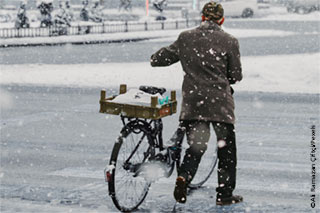Dutch people use bicycles in the winter months about twice as often as their German neighbours. In general, cycling is more common in the Netherlands than in Germany. In summer (June to August), 23 percent of all journeys are made by bicycle by Dutch people, compared to 16.7 percent in Germany. In winter (December to February), Dutch people also use their bicycles for 20.5 percent of their journeys. In contrast, Germans only cycle 10.3 percent of their journeys during this period.
The seasonal differences in bicycle use are therefore less pronounced in the Netherlands than in Germany. This is shown in a study by Dr Ansgar Hudde from the Institute of Sociology and Social Psychology (ISS) at the Faculty of Management, Economics and Social Sciences. Hudde attributes the differences in bicycle use to different mobility cultures in the two countries. The study was published under the title "It's the mobility culture, stupid! Winter conditions strongly reduce bicycle usage in German cities, but not in Dutch ones" in the Journal of Transport Geography.
Since the climatic conditions for cycling are similar in the Netherlands and Germany, this cannot explain the differences in bicycle use. "The joint analysis of behavioural and climate data shows: We in Germany are more sensitive to cold and darkness. The fact that Dutch people tend to cycle all year and Germans only in summer is not due to a different climate, but to different mobility cultures," explains Dr Hudde. In Germany there is a cycling culture that reflects and promotes such seasonal patterns. This can be seen, for example, in the term "cycling season", which means that there is one season in which people cycle, but which also means that people do not cycle during the rest of the year. "Also cycling campaigns, like 'city cycling' or 'cycle to work' only take place in summer," Hudde continues. "They send out the signal that people cycle in summer, but not in winter."
For his study, Ansgar Hudde evaluated representative statistical surveys on mobility in Germany and the Netherlands. He used data from 335,000 journeys made by a total of 98,000 inhabitants from 263 medium-sized and large cities. These mobility data were linked with city-specific climate data and analysed together. Since bicycle use differs greatly between urban and rural residents, the statistical analysis was limited to medium-sized and large cities (with more than 50,000 inhabitants).
The results of the study are relevant for the discussion on sustainable transport policy. If more people also travel by bike in autumn and winter, this reduces CO2 and particulate matter emissions and can go some way towards avoiding traffic jams or congestion on public transport. "If you are stuck in traffic jams by car in winter and see relatively empty cycle lanes, then you might be doubly annoyed by car lanes being converted into cycle lanes," Hudde said. If the cycle lanes are well used all year round, this can lead to more support for cycling promotion. Greater cycling use in winter could be achieved, for example, through better lighting of the cycle paths. Cycling events that take place in winter can also help make cycling more popular in Germany during the colder months. Hudde sums up: "the Netherlands show: there is still huge potential for a better traffic situation and more sustainability when it comes to all-season cycling".
